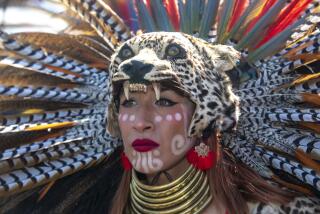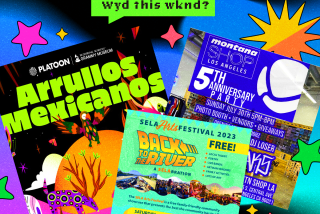Cajun and Creole Rhythms Spice Up Simi Festival
- Share via
SIMI VALLEY — It sounds like a grade-school joke: How do you get an alligator on a stick?
On Sunday, the answer was easy. Just hop in line at the 10th annual Cajun Creole Music Festival in Simi Valley, where not only could you get the aforementioned reptile-kebab, but also heaps of jambalaya, gumbo, oyster po’ boys and a day full of turns on the dance floor.
On the crowded floor, seasoned old-timers in fringe and cowboy boots shared twirling space with young people sporting buzz cuts dancing to the bubbly zydeco and Cajun swing music played by such favorites as Doug Kershaw and locals like Acadiana from Ventura.
Even lifelong Californians couldn’t resist the lure of experiencing New Orleans’ percolating southern charm.
“It gets you going, gets your toe tapping,” said Tom Spampinato of Simi Valley, who arrived in a Memorial Day outfit of red, white and blue, complemented by Mardi Gras beads. “Everyone’s mellow and cool.”
Hosted by the Rotary Club of Simi Sunrise, proceeds from the annual event go to several charities. Organizers were expecting about 13,000 celebrants for the two-day event, hoping to raise about $100,000.
“Every year it just gets bigger and better,” said Louis Kruglov, a Rotary Club member and chairman of the event, who could have passed for Mardi Gras royalty in his tall hat and heavy layers of beads.
For Jerome Stevens, who with his partner runs Southern Delite’s, a New Orleans-style caterer out of Santa Maria, the event was like a quick trip back home to Lafayette, La., where he grew up eating the kind of fare he now serves to Californians.
“I grew up in the same neighborhood as all these zydeco stars,” he said.
Zydeco and Cajun music, he notes, aren’t necessarily the same thing. Zydeco is more bluesy, influenced by African American culture; Cajun leans toward country and western, he said.
“Both tell a story,” he said. “They’re history,” a reminder of all the influence--Caribbean and French, country and blue--that created the regional culture.
Stevens’ booth served up the Cajun and Creole classics: steaming ladles of spicy gumbo, thick with shrimp, chicken and okra, and racks of ribs, with a sharp and tasty sting of heat. Stevens, of Creole descent, likes to taste the spices.
“We use a lot of cayenne pepper,” he said of the Creole people, whose ancestors are African. “We like it hot.”
And there was catfish, too, coated in corn meal, and grilled ears of corn, and heaping helpings of red beans and rice.
In the balmy spring weather, many who attended wore ventilated Panama hats or waved peacock feathers to keep cool, and cowboy boots or short skirts just right for spinning.
They scanned booths, eyeing jewelry and crafts. Their kids hopped in the inflated jump house, and fashioned Mardi Gras masks from felt and glitter for an afternoon parade.
And even some of those who felt they had two left feet ventured onto the dance floor.
“I like to watch the dancers,” said Claudia Wilson of Camarillo, who stood in a twisting line waiting for a chance at a mound of boiled-red crawfish. “I’m not a good dancer, but I’ve been out there.”
Some even found they had a knack for it.
“They’ll dance on this floor until the last moment,” said Kruglov. “They’re here until you have to ask them to leave, when the band’s packing up and we’re shutting down.”
Packing-up and shutting-down time was scheduled to be 7:30 p.m.
More to Read
Sign up for The Wild
We’ll help you find the best places to hike, bike and run, as well as the perfect silent spots for meditation and yoga.
You may occasionally receive promotional content from the Los Angeles Times.






